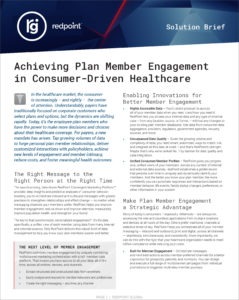 While much of the healthcare industry has been turned upside down because of COVID-19, the global pandemic is a reminder that innovation in healthcare consumer engagement, education, testing, and treatment is at the core of improving outcomes for all Americans. Once we get through the emergent health crisis, it will be important to leverage innovations in consumer engagement to acquire, retain, and deliver better outcomes at lower costs for the healthcare consumer.
While much of the healthcare industry has been turned upside down because of COVID-19, the global pandemic is a reminder that innovation in healthcare consumer engagement, education, testing, and treatment is at the core of improving outcomes for all Americans. Once we get through the emergent health crisis, it will be important to leverage innovations in consumer engagement to acquire, retain, and deliver better outcomes at lower costs for the healthcare consumer.
The Department of Health and Human Services publishes and tracks leading health indicators (LHI), a group of high-priority health issues that demonstrate and draw attention to factors that affect individual health and contribute to health disparities. They include access to health services, social determinants of health, clinical preventive services, mental health, and nutrition/physical activity/obesity.
Guiding an individual health consumer to best influence the controllable factors is an important way for healthcare professionals – payers and providers – to achieve better outcomes and lower costs. Reducing gaps in care and driving health risk assessment completion are two key focus areas. Others are a focus on value-based care (VBC) engagement, the acquisition of Medicare and Affordable Care Act (ACA) healthcare consumers, and provider onboarding and navigation.
Acquiring Medicare and ACA healthcare consumers are important segments not only for revenue growth for both payers and providers, but also because preventive care measures directed to those consumers achieve the greatest health outcomes. Revenue opportunities include financial incentives to reduce gaps in care as well as take on more risk for VBC arrangements.
A focus on reducing gaps in care for many clinical preventive services is another big opportunity. For example, according to the Centers for Disease Control and Prevention (CDC), colorectal cancer screenings beginning at age 50 are the most effective way to reduce a person’s risk of getting the disease. However, only 25 percent of adults age 50 to 64 in the US – and fewer than 40 percent over age 65 – are up to date on this screening. Some consumers may simply be unaware that there are now noninvasive screening options pioneered by Mayo Clinic and now widely available. In addition to seasonal and age-related screenings, other focus areas include prescription adherence, chronic condition management, telemedicine innovations, and IoT connected devices.
What these examples of value-added opportunities share is a single point of control over healthcare consumer data, decisions, and interactions to drive down costs and produce better outcomes.
To determine how to best achieve value from a single point of control, a worthwhile exercise for a healthcare organization is to analyze a population under care and develop applicable proofs of concept projects. A focus on a specific LHI or issues such as prescription adherence or management of a chronic condition present relatively low-hanging fruit that, while perhaps small in scope, provide far-reaching value with potential for measurable results in a short period of time.
Show Me: Trailblazers Carve out a Path
Redpoint customers in the healthcare industry have paved the way for other data-driven healthcare organizations to follow. One healthcare center tested the use of personalized communications to increase the percentage of consumers scheduling appointments. One group of healthcare consumers received personalized messaging, such as emails and SMS messages from a specific provider instead of a generic message from the medical center. Other personalized touches included listing a provider’s specialties relevant to the consumer’s condition, and including a picture of the provider in an email. Among some demographics, the population that received personalized touches scheduled 50 percent more appointments.
A New England-based hospital turned to Redpoint as a technology partner for an innovative telemedicine research program that targeted a population of healthcare consumers under care management for congestive heart failure. With help from a third-party vendor that managed IoT sensor data, the Redpoint platform analyzed live clinical data and generated real-time decisioning that dictated an optimal response – an at-home nurse visit, a message on a wristband, a video teleconference, or other next-best action intended to avoid the need for hospitalization re-admittance.
Your Data, Your Project, Your Accomplished Goals
Devising a proof of concept starts with an organization determining where it can find a quick win. For instance, addressing a glaring inefficiency or gap in care that it can tackle using data from a population under care that it already possesses.
Redpoint will help set up a proof of concept project using your own organization’s data, to test out specific use cases to determine ROI potential. An important differentiator of the Redpoint platform is that it provides organizations with a single view of the healthcare consumer – meaning that the data isn’t just a list of non-compliant consumers. Rather, advanced identity resolution capabilities narrow a healthcare consumer to a single identity across all devices and interactions, including behavioral, clinical, and claims data.
A single view greatly enhances test and learn capabilities during a proof of concept, because it’s the basis for determining a next-best action for an individual healthcare consumer. With a single view, the organization knows the consumer’s channel preference, for example, and will optimize communications accordingly. As we saw in the congestive heart failure case study, the single view becomes actionable with automated machine learning that analyzes live data. A real-time decisioning layer and intelligent orchestration provide the healthcare organization with a single point of control that produces the next-best action.
Testing various approaches – whether it’s a focus on personalization, frequency of contact, channels, etc. – will let the organization know which approach positively impacts individual behaviors. Once an organization proves what’s possible through a proof of concept, putting a model in production will allow for even more refinements as more data is collected and analyzed, thus allowing for even more finely tuned, relevant messages that will continually improve outcomes, drive down costs, or otherwise accomplish the desired goal.
RELATED CONTENT
Survey Says: Healthcare Personalization Has Room to Grow
Take a Data-Driven Approach to a Consumer’s Healthcare Journey
In a Heartbeat: The True Value of a CDP’s Real-Time Capabilities

